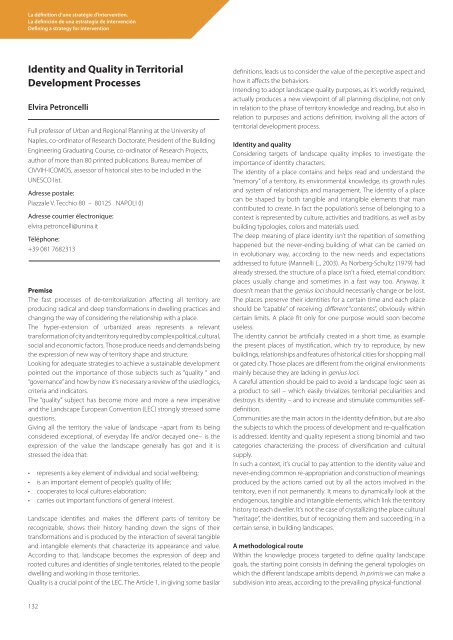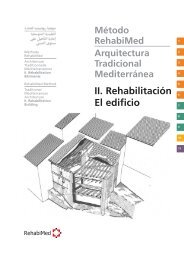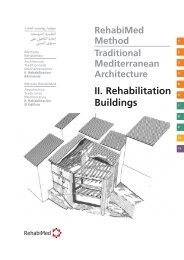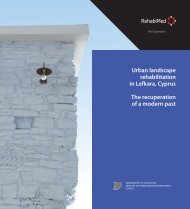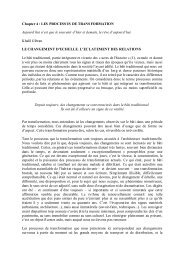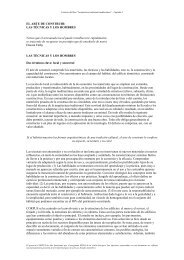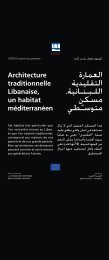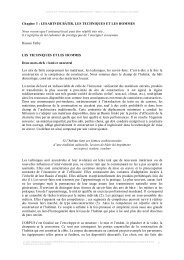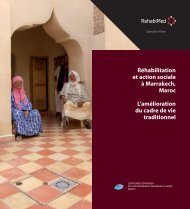La définition d'une stratégie d'intervention. La ... - RehabiMed
La définition d'une stratégie d'intervention. La ... - RehabiMed
La définition d'une stratégie d'intervention. La ... - RehabiMed
You also want an ePaper? Increase the reach of your titles
YUMPU automatically turns print PDFs into web optimized ePapers that Google loves.
<strong>La</strong> <strong>définition</strong> d’une <strong>stratégie</strong> d’intervention.<br />
<strong>La</strong> definición de una estrategia de intervención<br />
Defining a strategy for intervention<br />
Identity and Quality in Territorial<br />
Development Processes<br />
Elvira Petroncelli<br />
Full professor of Urban and Regional Planning at the University of<br />
Naples, co-ordinator of Research Doctorate, President of the Building<br />
Engineering Graduating Course, co-ordinator of Research Projects,<br />
author of more than 80 printed publications. Bureau member of<br />
CIVVIH-ICOMOS, assessor of historical sites to be included in the<br />
UNESCO list.<br />
Adresse postale:<br />
Piazzale V. Tecchio 80 – 80125 NAPOLI (I)<br />
Adresse courrier électronique:<br />
elvira.petroncelli@unina.it<br />
Téléphone:<br />
+39 081 7682313<br />
Premise<br />
The fast processes of de-territorialization affecting all territory are<br />
producing radical and deep transformations in dwelling practices and<br />
changing the way of considering the relationship with a place.<br />
The hyper-extension of urbanized areas represents a relevant<br />
transformation of city and territory required by complex political, cultural,<br />
social and economic factors. Those produce needs and demands being<br />
the expression of new way of territory shape and structure.<br />
Looking for adequate strategies to achieve a sustainable development<br />
pointed out the importance of those subjects such as “quality “ and<br />
“governance” and how by now it’s necessary a review of the used logics,<br />
criteria and indicators.<br />
The “quality” subject has become more and more a new imperative<br />
and the <strong>La</strong>ndscape European Convention (LEC) strongly stressed some<br />
questions.<br />
Giving all the territory the value of landscape –apart from its being<br />
considered exceptional, of everyday life and/or decayed one– is the<br />
expression of the value the landscape generally has got and it is<br />
stressed the idea that:<br />
<br />
<br />
<br />
<br />
<br />
<br />
<br />
<br />
<strong>La</strong>ndscape identifies and makes the different parts of territory be<br />
recognizable, shows their history handing down the signs of their<br />
transformations and is produced by the interaction of several tangible<br />
and intangible elements that characterize its appearance and value.<br />
According to that, landscape becomes the expression of deep and<br />
rooted cultures and identities of single territories, related to the people<br />
dwelling and working in those territories.<br />
Quality is a crucial point of the LEC. The Article 1, in giving some basilar<br />
definitions, leads us to consider the value of the perceptive aspect and<br />
how it affects the behaviors.<br />
Intending to adopt landscape quality purposes, as it’s worldly required,<br />
actually produces a new viewpoint of all planning discipline, not only<br />
in relation to the phase of territory knowledge and reading, but also in<br />
relation to purposes and actions definition, involving all the actors of<br />
territorial development process.<br />
Identity and quality<br />
Considering targets of landscape quality implies to investigate the<br />
importance of identity characters.<br />
The identity of a place contains and helps read and understand the<br />
“memory” of a territory, its environmental knowledge, its growth rules<br />
and system of relationships and management. The identity of a place<br />
can be shaped by both tangible and intangible elements that man<br />
contributed to create. In fact the population’s sense of belonging to a<br />
context is represented by culture, activities and traditions, as well as by<br />
building typologies, colors and materials used.<br />
The deep meaning of place identity isn’t the repetition of something<br />
happened but the never-ending building of what can be carried on<br />
in evolutionary way, according to the new needs and expectations<br />
addressed to future (Mannelli L., 2003). As Norberg-Schultz (1979) had<br />
already stressed, the structure of a place isn’t a fixed, eternal condition:<br />
places usually change and sometimes in a fast way too. Anyway, it<br />
doesn’t mean that the genius loci should necessarily change or be lost.<br />
The places preserve their identities for a certain time and each place<br />
should be “capable” of receiving different “contents”, obviously within<br />
certain limits. A place fit only for one purpose would soon become<br />
useless.<br />
The identity cannot be artificially created in a short time, as example<br />
the present places of mystification, which try to reproduce, by new<br />
buildings, relationships and features of historical cities for shopping mall<br />
or gated city. Those places are different from the original environments<br />
mainly because they are lacking in genius loci.<br />
A careful attention should be paid to avoid a landscape logic seen as<br />
a product to sell – which easily trivializes territorial peculiarities and<br />
destroys its identity – and to increase and stimulate communities selfdefinition.<br />
Communities are the main actors in the identity definition, but are also<br />
the subjects to which the process of development and re-qualification<br />
is addressed. Identity and quality represent a strong binomial and two<br />
categories characterizing the process of diversification and cultural<br />
supply.<br />
In such a context, it’s crucial to pay attention to the identity value and<br />
never-ending common re-appropriation and construction of meanings<br />
produced by the actions carried out by all the actors involved in the<br />
territory, even if not permanently. It means to dynamically look at the<br />
endogenous, tangible and intangible elements, which link the territory<br />
history to each dweller. It’s not the case of crystallizing the place cultural<br />
“heritage”, the identities, but of recognizing them and succeeding, in a<br />
certain sense, in building landscapes.<br />
A methodological route<br />
Within the knowledge process targeted to define quality landscape<br />
goals, the starting point consists in defining the general typologies on<br />
which the different landscape ambits depend. In primis we can make a<br />
subdivision into areas, according to the prevailing physical-functional<br />
132


